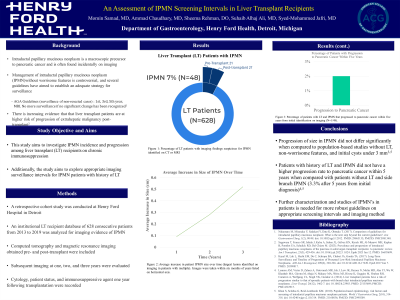Sunday Poster Session
Category: Liver
P0929 - An Assessment of IPMN Screening in Liver Transplant Recipients
Sunday, October 22, 2023
3:30 PM - 7:00 PM PT
Location: Exhibit Hall

Has Audio

Momin Samad, MD
Henry Ford Hospital
Rochester Hills, MI
Presenting Author(s)
Momin Samad, MD1, Ammad Chaudhary, MD2, Sheema Rehman, DO2, Suhaib Alhaj Ali, MD2, Syed-Mohammed Jafri, MD3
1Henry Ford Hospital, Rochester Hills, MI; 2Henry Ford Hospital, Detroit, MI; 3Henry Ford Health System, Detroit, MI
Introduction: Management of intraductal papillary mucinous neoplasm (IPMN) is controversial, and several guidelines have aimed to establish an adequate strategy for surveillance. There is increasing evidence that that liver transplant patients are at higher risk of progression of extrahepatic malignancy post-transplant. This study aims to investigate IPMN progression among liver transplant (LT) recipients on chronic immunosuppression.
Methods: A retrospective cohort study was conducted at an urban quaternary care center in midwestern United States. An institutional LT recipient database of 628 consecutive patients from 2013 to 2019 was analyzed for imaging evidence of IPMN. Computed tomography and magnetic resonance imaging obtained pre- and post-transplant were included. Subsequent imaging at one, two, and three years were evaluated. Cytology, patient status, and immunosuppressive agent one year following transplantation were recorded.
Results: The prevalence of suspected IPMN from the database was 7.6% (n=48). IPMN’s that were identified pre transplant comprised 44% (n=21) of the cohort. The average increase in size of IPMN at one, two, and three years after transplant was 0.09, 0.28, and 0.52 cm respectively. Two percent of patients (n=1) developed pancreatic adenocarcinoma.
Discussion: While general guidelines for IPMN screening vary, the data suggest that LT patients with IPMN’s follow similar courses. Further investigation is necessary to establish adequate surveillance intervals in this population.
Disclosures:
Momin Samad, MD1, Ammad Chaudhary, MD2, Sheema Rehman, DO2, Suhaib Alhaj Ali, MD2, Syed-Mohammed Jafri, MD3. P0929 - An Assessment of IPMN Screening in Liver Transplant Recipients, ACG 2023 Annual Scientific Meeting Abstracts. Vancouver, BC, Canada: American College of Gastroenterology.
1Henry Ford Hospital, Rochester Hills, MI; 2Henry Ford Hospital, Detroit, MI; 3Henry Ford Health System, Detroit, MI
Introduction: Management of intraductal papillary mucinous neoplasm (IPMN) is controversial, and several guidelines have aimed to establish an adequate strategy for surveillance. There is increasing evidence that that liver transplant patients are at higher risk of progression of extrahepatic malignancy post-transplant. This study aims to investigate IPMN progression among liver transplant (LT) recipients on chronic immunosuppression.
Methods: A retrospective cohort study was conducted at an urban quaternary care center in midwestern United States. An institutional LT recipient database of 628 consecutive patients from 2013 to 2019 was analyzed for imaging evidence of IPMN. Computed tomography and magnetic resonance imaging obtained pre- and post-transplant were included. Subsequent imaging at one, two, and three years were evaluated. Cytology, patient status, and immunosuppressive agent one year following transplantation were recorded.
Results: The prevalence of suspected IPMN from the database was 7.6% (n=48). IPMN’s that were identified pre transplant comprised 44% (n=21) of the cohort. The average increase in size of IPMN at one, two, and three years after transplant was 0.09, 0.28, and 0.52 cm respectively. Two percent of patients (n=1) developed pancreatic adenocarcinoma.
Discussion: While general guidelines for IPMN screening vary, the data suggest that LT patients with IPMN’s follow similar courses. Further investigation is necessary to establish adequate surveillance intervals in this population.
Disclosures:
Momin Samad indicated no relevant financial relationships.
Ammad Chaudhary indicated no relevant financial relationships.
Sheema Rehman indicated no relevant financial relationships.
Suhaib Alhaj Ali indicated no relevant financial relationships.
Syed-Mohammed Jafri: Gilead, Takeda, Abbvie – Advisor or Review Panel Member, Speakers Bureau.
Momin Samad, MD1, Ammad Chaudhary, MD2, Sheema Rehman, DO2, Suhaib Alhaj Ali, MD2, Syed-Mohammed Jafri, MD3. P0929 - An Assessment of IPMN Screening in Liver Transplant Recipients, ACG 2023 Annual Scientific Meeting Abstracts. Vancouver, BC, Canada: American College of Gastroenterology.
